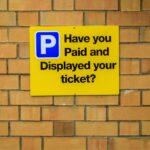Signage Essentials for a Well-Managed Parking Facility

Parking facilities are a critical component of modern urban infrastructure. Efficient management of these spaces is paramount for smooth traffic flow and user satisfaction.
A vital aspect of this management is the implementation of effective signage. Proper signage guides drivers and ensures safety and compliance with regulations.
The Role of Effective Signage in Parking Facilities
Effective signage in parking facilities serves several essential functions. It directs traffic flow, indicates parking spots, informs users of rules and regulations, and ensures pedestrian safety. Well-designed signs reduce confusion and enhance the overall efficiency of the parking area.
Understanding the Basics of Parking Facility Signage
The basics of parking facility signage encompass various elements – from the types of signs used to their design and placement. Understanding these fundamentals is crucial for creating an environment that is easy to navigate and safe for all users.
Key Elements of Parking Facility Signage
Certain key signage elements must be considered to create a well-managed parking facility.
Essential Types of Parking Signage and Their Functions
Different types of signage serve specific purposes in a parking facility. Entrance and exit signs, directional signs, speed limit signs, and pedestrian crossing signs are essential. Each type plays a role in guiding, informing, and ensuring the safety of the users.
Design Considerations for Clear and Effective Signs
The design of parking signs should prioritize clarity and readability. This includes choosing the right font size, color contrast, and sign placement. A well-designed sign conveys its message quickly and effectively to drivers and pedestrians.
Material Choices for Durable and Visible Parking Signs
The choice of material for parking signs is vital for durability and visibility. Materials should be weather-resistant and capable of maintaining their legibility over time. Reflective materials are often preferred for better night visibility.
The Importance of Color and Contrast in Signage
Color and contrast play a significant role in the effectiveness of parking signs. High-contrast color combinations, like black on white or red on white, are most effective for readability. Colors also help categorize different types of information – for instance, red for prohibitive actions and green for directional guidance.
Signage Placement and Visibility
Proper placement and visibility of signs are crucial for their effectiveness.
Strategic Placement of Signs for Optimal Visibility
Signs should be placed strategically where they are most visible to drivers and pedestrians. This includes decision points like intersections within the parking facility, near pedestrian crossings, and at entry and exit points.
Height and Sizing Standards for Parking Signs
There are standard height and sizing guidelines for parking signs to ensure they are visible from a distance and to drivers in different types of vehicles. Adhering to these standards ensures that the signs serve their intended purpose effectively.
Illumination Techniques for Nighttime Visibility
Illuminated signage is essential for parking facilities operating in the evening or night. This can be achieved through externally lit signs or using materials that naturally reflect vehicle headlights.
Regulatory Compliance and Safety Signage
Compliance with legal requirements and safety is non-negotiable in parking facility signage.
Navigating Legal Requirements for Parking Facility Signage
Each region has specific legal requirements for parking signage. These may include specifications for sign dimensions, text size, and the inclusion of specific symbols or wording. Compliance with these regulations is crucial to avoid legal complications and ensure user safety.
Safety Signage: Ensuring a Secure Parking Environment
Safety signage includes signs that warn of potential hazards, indicate emergency exits, or provide instructions in case of emergencies. These signs are critical in preventing accidents and ensuring a rapid response in case of an emergency.
ADA Compliance in Parking Facility Signage
Compliance with the Americans with Disabilities Act (ADA) is essential in the United States. This includes providing adequate signage for handicapped parking spaces and ensuring the signage is accessible and understandable to everyone, including those with disabilities.
Directional and Informational Signage
Directional and informational signs guide and inform users within the parking facility.
Crafting Effective Wayfinding Systems in Parking Facilities
A well-designed wayfinding system uses a combination of directional signs and maps to guide users through the parking facility. This system should be intuitive and consistent throughout the facility.
Informational Signs: Communicating Rules and Regulations
Informational signs communicate the rules and regulations of the parking facility. These include signs indicating parking fees, hours of operation, and any restrictions or special instructions.
Temporary Signage for Events and Special Occasions
For special events or occasions that affect the usual parking arrangements, temporary signage is necessary. These signs should be distinct but consistent with the permanent signage in terms of design and placement.
Technology Integration in Signage
Incorporating technology can greatly enhance the effectiveness of parking facility signage.
Digital Signage Solutions for Modern Parking Facilities
Digital signage offers flexibility and dynamic content management. These signs can display real-time information such as parking availability, special instructions, or emergency alerts.
Utilizing QR Codes and Mobile Integration in Parking Signs
QR codes on parking signs can provide additional information accessible through smartphones. This can include details about parking rates, navigation to available parking spots, or links to facility websites or apps.
User Experience and Customer Satisfaction
The ultimate goal of parking facility signage is to enhance the user experience and ensure customer satisfaction.
Enhancing User Experience Through Thoughtful Signage Design
Well-designed and strategically placed signage contributes significantly to a positive user experience. It can reduce stress, minimize confusion, and make parking more efficient.
Feedback Mechanisms: Understanding User Interaction with Signage
Incorporating feedback mechanisms like surveys or comment boxes helps understand how users interact with the signage. This feedback can be invaluable in making improvements.
Case Studies: Successful Parking Facility Signage Implementations
Examining case studies of successful signage implementations in parking facilities can provide valuable insights. These case studies often highlight innovative approaches and best practices that can be applied elsewhere.
Maintenance and Upkeep of Signage
Regular maintenance and upkeep are essential for the longevity and effectiveness of parking signs.
Routine Maintenance Practices for Long-Lasting Signs
Regular inspections and maintenance activities help in ensuring that signs remain visible, legible, and in good condition. This includes cleaning, repairing, or replacing signs as needed.
Addressing Vandalism and Weather-Related Challenges
Vandalism and weather conditions can damage signs. Strategies to mitigate these challenges include using vandal-resistant materials and designing signs to withstand local weather conditions.
Future Trends and Innovations in Parking Signage
Staying abreast of emerging trends and innovations is crucial for evolving parking facility signage.
Innovative Materials and Designs Shaping Future Signage
New materials and design approaches are continuously emerging in the signage industry. These innovations can offer improved durability, visibility, and environmental sustainability.
The Impact of Autonomous Vehicles on Parking Facility Signage
As autonomous vehicles become more prevalent, the design and functionality of parking signs may need to adapt. This could include integrating technology for vehicle-to-sign communication or redesigning signs to cater to autonomous navigation systems.
Conclusion and Best Practices
In conclusion, effective signage is a key component of a well-managed parking facility.
Summarizing Key Takeaways for Effective Parking Facility Signage
Effective parking facility signage enhances safety, improves traffic flow, and provides a positive user experience. Adhering to design standards legal requirements, and focusing on user needs are essential for successful signage.
Creating effective signage for a well-managed parking facility involves several key elements to ensure clarity, safety, and efficient traffic flow. Here are some essential aspects to consider:
- Entrance and Exit Signs:
Clearly marked entrance and exit signs are fundamental. They should be large and visible from a distance to guide drivers effectively. - Directional Signs:
Directional signs should guide drivers inside the facility to available parking spots, exits, elevators, and payment stations. Arrows and simple instructions help in navigating complex layouts. - Parking Area Identification:
Each area should be clearly labeled, possibly with a color code or alphanumeric system, to help users remember where they’ve parked. - Speed Limit and Traffic Flow Indicators:
Signs indicating speed limits and traffic flow directions (like one-way systems) are essential for safety and preventing confusion. - Pedestrian Safety Signs:
Signs should remind drivers to watch for pedestrians, especially in crossing areas and near elevators or stairs. - Height Restriction Warnings:
For facilities with height limitations, clearly marked signs at the entrance and within can prevent accidents. - Accessible Parking Signs:
Designated accessible parking spaces must be clearly marked and located near facility entrances. - Emergency Information:
Signs indicating the location of emergency exits, fire extinguishers, and instructions for emergencies are crucial. - Terms and Conditions:
For legal reasons, signs detailing the parking terms, conditions, and liability information are necessary. - Payment and Pricing Information:
Clearly display pricing rates and payment instructions near the entrance and payment stations. - Time Restrictions:
If there are time restrictions on parking, these should be communicated through signage. - Customer Service Information:
Providing contact information for facility management or assistance can be helpful for users. - Sustainability and Etiquette Reminders:
Encouraging eco-friendly practices and courteous behavior can be communicated through signage, enhancing the overall experience. - Technology Integration:
For modern parking facilities, signs integrating technology, like digital displays or QR codes for more information, can be highly effective. - Lighting for Visibility:
Ensure all signs are well-lit, particularly in facilities that operate during night hours.
By covering these aspects, a parking facility can provide a seamless, safe, and user-friendly experience for all its users.

